Jim Shooter's Blog, page 11
September 12, 2011
Heroes for Hope and Why I Don't Like Oxfam America
This is very frustrating. During the last week or two, I have held in my hands several items that now I cannot find. One was my copy of Heroes for Hope. The others were a press release and a PR photo regarding same. Now that I need them, where are they?
As I sort through boxes brought from my storage space, things get shuffled around, stacked here and there. Those things are neither here nor there. I must have put them aside very carefully someplace safe from the cats and apparently safe from me as well. Sigh.
They'll turn up. Then I'll show them to you.
Anyway….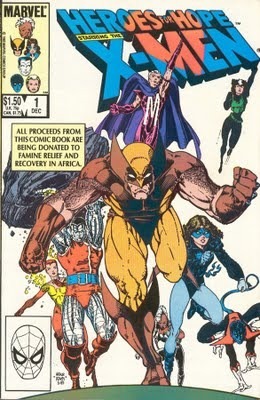
I suspect most people are familiar with the fact that in 1985 Marvel Comics published a comic book, Heroes for Hope, to raise money for East African famine relief. The idea came from Jim Starlin and Berni (now spelled Bernie) Wrightson. I think it was whatshisname Wrightson's suggestion, made to Starlin. Starlin is the one who brought it to me. He and Wrightson proposed that Marvel publish a special book the proceeds of which would be donated to a suitable charitable organization. They envisioned a "jam" book created by the biggest names and best creators we could find, each donating a page or two's work.
Starlin is very persuasive. He didn't have to be. I thought the idea was wonderful. I think I was the one who suggested that we star the X-Men in the book, to maximize sales. I could be wrong. If Starlin says that was his idea, believe him.
I walked the new project proposal through the vetting process. I am very persuasive. I didn't have to be. Everyone thought the idea was wonderful. I met no resistance.
I told X-Men editor Ann Nocenti and Chris Claremont about it. They thought the idea was wonderful. Chris really got behind it. He sort of took over and became team captain. Chris recruited big name writers, Starlin and Wrightson went after big name artists, and all three did brilliantly, wonderfully well. Ann was central fire control, governing and coordinating the whole project, aiding and abetting the recruiting process.
Starlin, Wrightson, Nocenti and Claremont did everything. I had the good sense to stay the hell out of their way.
They got people to contribute who probably wouldn't even have taken my call.
My input was fairly minor. I worked with Chris and Ann on the plot a little. Mostly I was the Structure Enforcer. I made sure the story worked and that it could be parceled into one, two and three page sections to make life easier on the jammers. We gave Stan the first pages to write and Archie Goodwin the last ones, so the team would have heavy-hitter, comics-experienced people anchoring the effort on either end. I wrote two pages in the middle somewhere, drawn by Alan Weiss, inked by Joe Rubinstein, lettered by John (Jack) Morelli and colored by Christie Scheele. They looked great.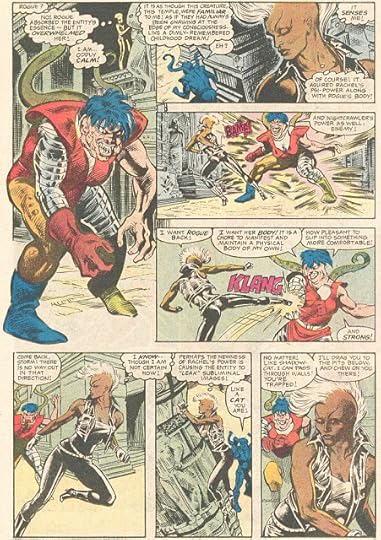 Pages 40-41 Drawn by Alan Weiss, Written by Jim Shooter
Pages 40-41 Drawn by Alan Weiss, Written by Jim Shooter
 We had no shortage of volunteers. Everyone wanted to participate. I hated the fact that so many were willing and so few spots were available. I think Chris and Ann did a pretty good job of mixing Marvel writers, experienced comics pros, with stars from other fields.
We had no shortage of volunteers. Everyone wanted to participate. I hated the fact that so many were willing and so few spots were available. I think Chris and Ann did a pretty good job of mixing Marvel writers, experienced comics pros, with stars from other fields.
The non-comics writers who participated needed some help in most cases, which Ann and Chris provided. The biggest challenge was Stephen King's contribution. I may be exaggerating here, but not by much—he gave us something like 5,000 words for three pages. Almost overnight, by the way. Chris, Ann and I somehow cut that down to what would fit on three comics pages. 500 words? I forget. Has anyone else ever had to cut out 90% of Stephen King's brilliant words?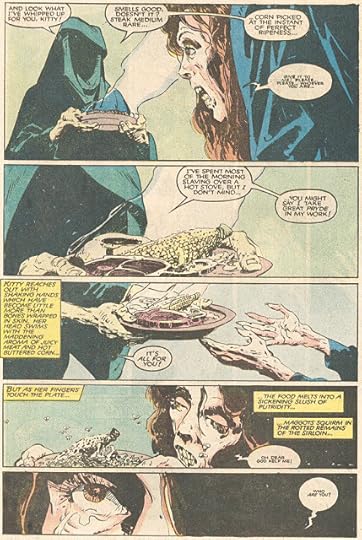 Page 11 Drawn by Berni Wrightson, Written by Stphen KingMeanwhile….
Page 11 Drawn by Berni Wrightson, Written by Stphen KingMeanwhile….
Pam Rutt, Marvel's PR director, really got behind this project. That was refreshing. I loved Pam, but sometimes it was hard to get her to grok the significance of what, to us comics people were clearly big events. Spider-Man's black costume for instance. I pitched that to her as a PR op. Nah, she said, no one will care.
Imagine her surprise the day the first Spider-Man black costume issue came out when we were swamped with calls from major newspapers, the wire services and news media outlets across the country. Never saw a PR department scramble so fast….
Pam wasn't a comics person. Almost no one at Marvel outside my department and some of the sales department was. Most Marvel execs would proudly tell you that they had never even opened a comic book (thereby preserving their "adult" image).
Once the V.P. of licensing told me excitedly that she'd just made a great deal for Wonder Woman. I pointed out to her that Wonder Woman didn't belong to us. She was nonplussed. I told her to call the woman at LCA who handled the DC characters—I can't call her name to mind at the moment—and pretend that she had just warmed the potential client up for her.
Once our V.P. of Promotions, who mostly spent her time arranging for Marvel's costumed actors to appear at events like the White House Easter Egg Roll or ribbon cuttings at malls called me to ask how many stories were in each issue. You get the drift.
Pam got behind what you'd expect a civilian to get behind—the anti-child abuse comic we did with the National Committee for the Prevention of Child Abuse, the launch of Marvel's children's book line, etc. Heroes for Hope was right in her wheelhouse. When she embraced a PR op, she did a great job. She was/is brilliant, if not comics literate.
Anyway….
Pam had arranged for Oxfam America to receive our donation. Their reaction to our offer, at first, was what one might expect from people who had never seen a comic book up close: "Comic book? There's nothing funny about famine!" Sigh.
For some reason Pam was determined that we should donate the money to them, though, and we convinced them that comics weren't always comic. They still demanded to review the finished book before they would commit to accept our donation.
Okay….
When the book was ready to go to press, we sent a mock-up to Oxfam America to review.
Their response was that they wanted nothing to do with it. Flat rejection.
Furthermore, they said that the book was unbelievably offensive and that we, the people of Marvel Comics, were racist, sexist and reprehensible.
When this was told to me by Pam and Marvel President Jim Galton I felt as if I were being called on the carpet. I was flabbergasted. I showed them the mock-up.
They didn't see anything wrong with it.
Galton called the exec at Oxfam America we'd been dealing with to ask what their specific objections were.
Their response was that, while under no circumstances would they have anything to do with our project or with us, they would send an executive to meet with us and explain the many horrific, repugnant, disgusting elements that made our "comic book" anathema.
So they did. Oxfam America's representative came to meet with Galton and me. The meeting took place in Galton's office.
I do not remember the man's name.
He was a nice-looking, thirty-something man. He had on a suit that probably cost more than my entire wardrobe. Designer shoes. He had on more gold and diamond jewelry than I'd ever seen on a human being. Jeweled watch. Cufflinks. Stickpin. Bracelets. A neck chain that would make a rapper blush. Doubt me, go ahead. Discount by two-thirds what I'm telling you and you should still have an image of a guy wearing clothes and jewelry that at market price would feed a thousand starving people for a month.
After the greetings and handshaking, Galton, making conversation, said that he imagined that Oxfam America and other charitable organizations had, at least, gotten a lot of people to focus on the ongoing tragedy in Africa, and had inspired many efforts such as ours from musicians and performers and artists.
This Oxfam America fellow, let's call him Midas, just plain gushed about how good for business the East African famine was, how donations were rolling in at record levels. He talked about the millions dying as if it were a great marketing opportunity.
Galton and I were stupefied. We couldn't believe how thrilled Midas was that his business was booming.
Midas explained that the purpose of his visit wasn't here to request changes or negotiate. He had come to save us from our own folly. He made it clear that Oxfam America had nothing but contempt for us and our work. He came as a favor, to urge us not to publish the abomination that we had created. He assured us that it would destroy Marvel Comics.
Right. Well, naturally, I wondered why.
Midas flipped through the mock-up. Again and again he pointed out black characters that he said "looked like Michael Jackson." We were obviously trying to capitalize on Michael Jackson's image and fame.
 Page 33 Drawn by Herb Trimpe, Written by George Martin
Page 33 Drawn by Herb Trimpe, Written by George Martin
 Page 28 Drawn by John Boltin, Written by Jo Duffy Michael Jackson in particular and the Jackson family in general were huge supporters of Oxfam America, by the way.
Page 28 Drawn by John Boltin, Written by Jo Duffy Michael Jackson in particular and the Jackson family in general were huge supporters of Oxfam America, by the way.
Every drawing of a woman, he said, was sexist and exploitative. He was particularly offended by depictions of Storm, which he thought were more than sexist, a denigration of women of color.
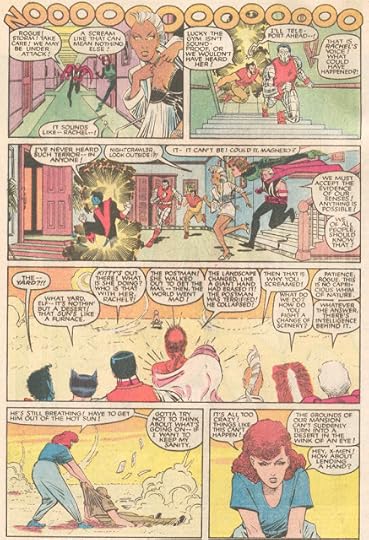 Page 2 Drawn by JR, Jr., Written by Stan Lee
Page 2 Drawn by JR, Jr., Written by Stan Lee
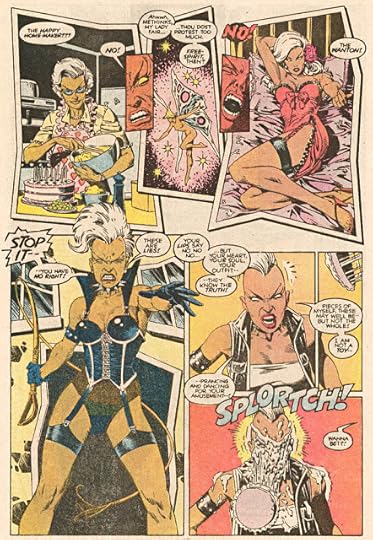 Page 26 Drawn by Brian Bolland, Written by Chris Claremont I mentioned that the men were heroic and glamorous, too. Just like in the movies, stars tend to be good looking.
Page 26 Drawn by Brian Bolland, Written by Chris Claremont I mentioned that the men were heroic and glamorous, too. Just like in the movies, stars tend to be good looking.
He pointed out a panel in which Chris had a carnival barker saying: "Yowza…." That, he said, was racist in the extreme. I don't have the book handy, as explained above, but wasn't that character Caucasian?
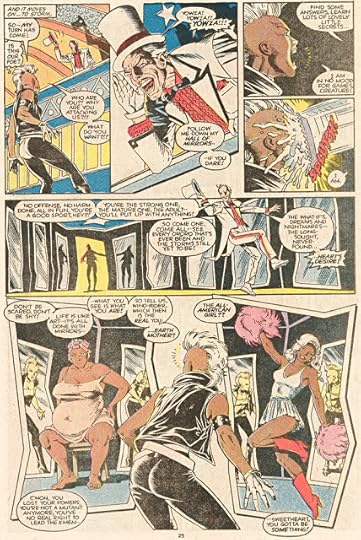 Page 25 Drawn by Brian Bolland, Written by Chris Claremont Moore and Corben's pages? Yikes.
Page 25 Drawn by Brian Bolland, Written by Chris Claremont Moore and Corben's pages? Yikes.
I cannot begin to tell you all the racism, sexism and hate that he (and Oxfam America) read into the words and pictures.
Wow.
The punch line is this: Midas accused Marvel of "stealing Janet Jackson's logo." He believed that the Heroes for Hope logo, credited to Janet Jackson, was ripped off.
I offered to introduce him to the designer on our staff who had created the logo, one Miss Janet Claire Jackson. He dismissed my obvious attempt at a cover-up.
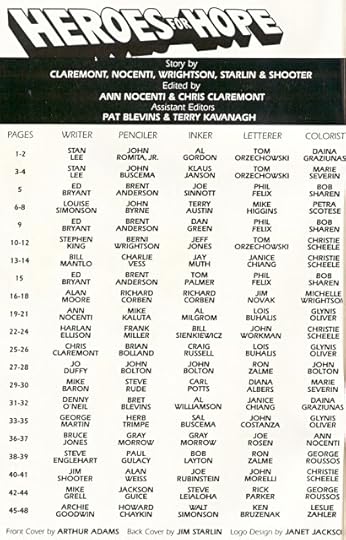 No, really, we have a designer named…. Oh, never mind.
No, really, we have a designer named…. Oh, never mind.
No wonder Janet Claire Jackson eventually started going by the name "Blog Elf."
Finally, the lunatic left. Galton and I shared a moment of "what a jerk."
Pam was instructed to find some other organization to which to donate the money. She came up with the American Friends Service Committee.
Here's their acceptance letter.

 Heroes for Hope was a huge success. Thanks to our sales department, we got donations from downstream—distributors, retailers, even fans.
Heroes for Hope was a huge success. Thanks to our sales department, we got donations from downstream—distributors, retailers, even fans.
Can't find the press release and the picture of me and Galton giving the AFSC honchos the PR "Big Check" created by our production department to symbolize the real check. I think the initial donation was $500,000. Much more came later.
It was a great thing. Jim Starlin, Bernie Wrightson, Ann Nocenti and Chris Claremont are great heroes in my book. Heroes for hope. There are people alive today who wouldn't be without their efforts.
Thanks to everyone who helped, and everyone who wanted to but couldn't because there wasn't room. It was one of our finest hours.
NEXT, A DAY OFF. THEN, I DON"T KNOW, BUT SOMETHING GROOVY

As I sort through boxes brought from my storage space, things get shuffled around, stacked here and there. Those things are neither here nor there. I must have put them aside very carefully someplace safe from the cats and apparently safe from me as well. Sigh.
They'll turn up. Then I'll show them to you.
Anyway….

I suspect most people are familiar with the fact that in 1985 Marvel Comics published a comic book, Heroes for Hope, to raise money for East African famine relief. The idea came from Jim Starlin and Berni (now spelled Bernie) Wrightson. I think it was whatshisname Wrightson's suggestion, made to Starlin. Starlin is the one who brought it to me. He and Wrightson proposed that Marvel publish a special book the proceeds of which would be donated to a suitable charitable organization. They envisioned a "jam" book created by the biggest names and best creators we could find, each donating a page or two's work.
Starlin is very persuasive. He didn't have to be. I thought the idea was wonderful. I think I was the one who suggested that we star the X-Men in the book, to maximize sales. I could be wrong. If Starlin says that was his idea, believe him.
I walked the new project proposal through the vetting process. I am very persuasive. I didn't have to be. Everyone thought the idea was wonderful. I met no resistance.
I told X-Men editor Ann Nocenti and Chris Claremont about it. They thought the idea was wonderful. Chris really got behind it. He sort of took over and became team captain. Chris recruited big name writers, Starlin and Wrightson went after big name artists, and all three did brilliantly, wonderfully well. Ann was central fire control, governing and coordinating the whole project, aiding and abetting the recruiting process.
Starlin, Wrightson, Nocenti and Claremont did everything. I had the good sense to stay the hell out of their way.
They got people to contribute who probably wouldn't even have taken my call.
My input was fairly minor. I worked with Chris and Ann on the plot a little. Mostly I was the Structure Enforcer. I made sure the story worked and that it could be parceled into one, two and three page sections to make life easier on the jammers. We gave Stan the first pages to write and Archie Goodwin the last ones, so the team would have heavy-hitter, comics-experienced people anchoring the effort on either end. I wrote two pages in the middle somewhere, drawn by Alan Weiss, inked by Joe Rubinstein, lettered by John (Jack) Morelli and colored by Christie Scheele. They looked great.
 Pages 40-41 Drawn by Alan Weiss, Written by Jim Shooter
Pages 40-41 Drawn by Alan Weiss, Written by Jim Shooter
 We had no shortage of volunteers. Everyone wanted to participate. I hated the fact that so many were willing and so few spots were available. I think Chris and Ann did a pretty good job of mixing Marvel writers, experienced comics pros, with stars from other fields.
We had no shortage of volunteers. Everyone wanted to participate. I hated the fact that so many were willing and so few spots were available. I think Chris and Ann did a pretty good job of mixing Marvel writers, experienced comics pros, with stars from other fields.The non-comics writers who participated needed some help in most cases, which Ann and Chris provided. The biggest challenge was Stephen King's contribution. I may be exaggerating here, but not by much—he gave us something like 5,000 words for three pages. Almost overnight, by the way. Chris, Ann and I somehow cut that down to what would fit on three comics pages. 500 words? I forget. Has anyone else ever had to cut out 90% of Stephen King's brilliant words?
 Page 11 Drawn by Berni Wrightson, Written by Stphen KingMeanwhile….
Page 11 Drawn by Berni Wrightson, Written by Stphen KingMeanwhile….Pam Rutt, Marvel's PR director, really got behind this project. That was refreshing. I loved Pam, but sometimes it was hard to get her to grok the significance of what, to us comics people were clearly big events. Spider-Man's black costume for instance. I pitched that to her as a PR op. Nah, she said, no one will care.
Imagine her surprise the day the first Spider-Man black costume issue came out when we were swamped with calls from major newspapers, the wire services and news media outlets across the country. Never saw a PR department scramble so fast….
Pam wasn't a comics person. Almost no one at Marvel outside my department and some of the sales department was. Most Marvel execs would proudly tell you that they had never even opened a comic book (thereby preserving their "adult" image).
Once the V.P. of licensing told me excitedly that she'd just made a great deal for Wonder Woman. I pointed out to her that Wonder Woman didn't belong to us. She was nonplussed. I told her to call the woman at LCA who handled the DC characters—I can't call her name to mind at the moment—and pretend that she had just warmed the potential client up for her.
Once our V.P. of Promotions, who mostly spent her time arranging for Marvel's costumed actors to appear at events like the White House Easter Egg Roll or ribbon cuttings at malls called me to ask how many stories were in each issue. You get the drift.
Pam got behind what you'd expect a civilian to get behind—the anti-child abuse comic we did with the National Committee for the Prevention of Child Abuse, the launch of Marvel's children's book line, etc. Heroes for Hope was right in her wheelhouse. When she embraced a PR op, she did a great job. She was/is brilliant, if not comics literate.
Anyway….
Pam had arranged for Oxfam America to receive our donation. Their reaction to our offer, at first, was what one might expect from people who had never seen a comic book up close: "Comic book? There's nothing funny about famine!" Sigh.
For some reason Pam was determined that we should donate the money to them, though, and we convinced them that comics weren't always comic. They still demanded to review the finished book before they would commit to accept our donation.
Okay….
When the book was ready to go to press, we sent a mock-up to Oxfam America to review.
Their response was that they wanted nothing to do with it. Flat rejection.
Furthermore, they said that the book was unbelievably offensive and that we, the people of Marvel Comics, were racist, sexist and reprehensible.
When this was told to me by Pam and Marvel President Jim Galton I felt as if I were being called on the carpet. I was flabbergasted. I showed them the mock-up.
They didn't see anything wrong with it.
Galton called the exec at Oxfam America we'd been dealing with to ask what their specific objections were.
Their response was that, while under no circumstances would they have anything to do with our project or with us, they would send an executive to meet with us and explain the many horrific, repugnant, disgusting elements that made our "comic book" anathema.
So they did. Oxfam America's representative came to meet with Galton and me. The meeting took place in Galton's office.
I do not remember the man's name.
He was a nice-looking, thirty-something man. He had on a suit that probably cost more than my entire wardrobe. Designer shoes. He had on more gold and diamond jewelry than I'd ever seen on a human being. Jeweled watch. Cufflinks. Stickpin. Bracelets. A neck chain that would make a rapper blush. Doubt me, go ahead. Discount by two-thirds what I'm telling you and you should still have an image of a guy wearing clothes and jewelry that at market price would feed a thousand starving people for a month.
After the greetings and handshaking, Galton, making conversation, said that he imagined that Oxfam America and other charitable organizations had, at least, gotten a lot of people to focus on the ongoing tragedy in Africa, and had inspired many efforts such as ours from musicians and performers and artists.
This Oxfam America fellow, let's call him Midas, just plain gushed about how good for business the East African famine was, how donations were rolling in at record levels. He talked about the millions dying as if it were a great marketing opportunity.
Galton and I were stupefied. We couldn't believe how thrilled Midas was that his business was booming.
Midas explained that the purpose of his visit wasn't here to request changes or negotiate. He had come to save us from our own folly. He made it clear that Oxfam America had nothing but contempt for us and our work. He came as a favor, to urge us not to publish the abomination that we had created. He assured us that it would destroy Marvel Comics.
Right. Well, naturally, I wondered why.
Midas flipped through the mock-up. Again and again he pointed out black characters that he said "looked like Michael Jackson." We were obviously trying to capitalize on Michael Jackson's image and fame.
 Page 33 Drawn by Herb Trimpe, Written by George Martin
Page 33 Drawn by Herb Trimpe, Written by George Martin
 Page 28 Drawn by John Boltin, Written by Jo Duffy Michael Jackson in particular and the Jackson family in general were huge supporters of Oxfam America, by the way.
Page 28 Drawn by John Boltin, Written by Jo Duffy Michael Jackson in particular and the Jackson family in general were huge supporters of Oxfam America, by the way.Every drawing of a woman, he said, was sexist and exploitative. He was particularly offended by depictions of Storm, which he thought were more than sexist, a denigration of women of color.
 Page 2 Drawn by JR, Jr., Written by Stan Lee
Page 2 Drawn by JR, Jr., Written by Stan Lee
 Page 26 Drawn by Brian Bolland, Written by Chris Claremont I mentioned that the men were heroic and glamorous, too. Just like in the movies, stars tend to be good looking.
Page 26 Drawn by Brian Bolland, Written by Chris Claremont I mentioned that the men were heroic and glamorous, too. Just like in the movies, stars tend to be good looking.He pointed out a panel in which Chris had a carnival barker saying: "Yowza…." That, he said, was racist in the extreme. I don't have the book handy, as explained above, but wasn't that character Caucasian?
 Page 25 Drawn by Brian Bolland, Written by Chris Claremont Moore and Corben's pages? Yikes.
Page 25 Drawn by Brian Bolland, Written by Chris Claremont Moore and Corben's pages? Yikes.I cannot begin to tell you all the racism, sexism and hate that he (and Oxfam America) read into the words and pictures.
Wow.
The punch line is this: Midas accused Marvel of "stealing Janet Jackson's logo." He believed that the Heroes for Hope logo, credited to Janet Jackson, was ripped off.

I offered to introduce him to the designer on our staff who had created the logo, one Miss Janet Claire Jackson. He dismissed my obvious attempt at a cover-up.
 No, really, we have a designer named…. Oh, never mind.
No, really, we have a designer named…. Oh, never mind.No wonder Janet Claire Jackson eventually started going by the name "Blog Elf."
Finally, the lunatic left. Galton and I shared a moment of "what a jerk."
Pam was instructed to find some other organization to which to donate the money. She came up with the American Friends Service Committee.
Here's their acceptance letter.

 Heroes for Hope was a huge success. Thanks to our sales department, we got donations from downstream—distributors, retailers, even fans.
Heroes for Hope was a huge success. Thanks to our sales department, we got donations from downstream—distributors, retailers, even fans.Can't find the press release and the picture of me and Galton giving the AFSC honchos the PR "Big Check" created by our production department to symbolize the real check. I think the initial donation was $500,000. Much more came later.
It was a great thing. Jim Starlin, Bernie Wrightson, Ann Nocenti and Chris Claremont are great heroes in my book. Heroes for hope. There are people alive today who wouldn't be without their efforts.
Thanks to everyone who helped, and everyone who wanted to but couldn't because there wasn't room. It was one of our finest hours.
NEXT, A DAY OFF. THEN, I DON"T KNOW, BUT SOMETHING GROOVY
Published on September 12, 2011 17:23
September 9, 2011
No, Really, This Time for Sure, the Startling Conclusion of the Submissions Saga
Back when I was a kid, in the letter columns of Adventure Comics featuring Superboy and the Legion of Super-Heroes there was a section entitled "Bits of Legionnaire Business." Readers sent in ideas for new Legionnaires—names and short descriptions of their powers—and editor Mort Weisinger would publish the most interesting ones. A few times, Mort asked me to take an idea from "Bits…" and develop a character based on it. I remember that Shadow Lass was one such character. There might have been others.
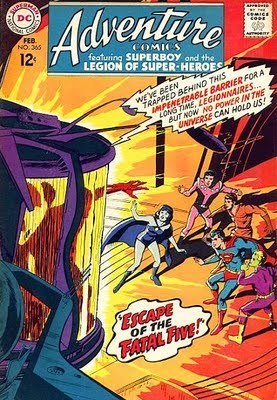
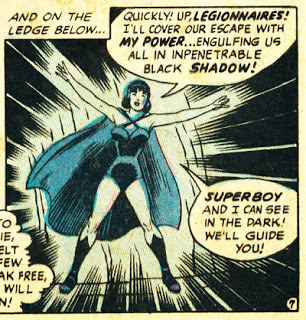
That was back in the 1960's, of course. Readers were pleased and honored to see their suggestions make the "Bits…" section and apparently thrilled if their idea was developed into a continuing character. Seeing your name, your character's name and five-word description in print was great, and seeing your character developed and appearing on panel, well…that was awesome. Reward enough for your efforts.
"Bits of Legionnaire Business" Excerpts
No, this isn't a nostalgic yearning for the good old days. I wondered about the propriety of that practice even then. These days, I wonder about news and weather shows on TV that invite people to send in pictures or video. Let's see, I send you spectacular video that fills air time for you and my reward is seeing my effort on TV, helping you amuse your audience and make your money…. Hmm.
Nah.
As far as I know, we never used anything without compensation from the submissions and samples we reviewed by the literal ton at Marvel back while I was there, 1976-87. There were some cases in which we saw something, liked it and bought it. The Black Spider-Man costume comes to mind. The correspondent sent in a sample plot in which Spider-Man is given a new, black costume by Reed Richards that has high-tech features. I called the guy up. His plot wasn't up to professional standards, but I offered to pay him for it anyway, to "buy the idea." He was very happy with that.
I had no thought about where or when I might want to put Spider-Man in a black costume. I put a note in my drawer. A long time later, maybe a year, I needed an event for Secret Wars and remembered the black costume idea. I figured it was going to be a throwaway bit, something we'd use once.
Developed first by me, then by David Michelinie and editor Jim Owsley (now Christopher Priest), the costume became a character and went on to great things, even being featured in a movie. Though the only thing he contributed to the black Spider-Man costume were, essentially, the two words "black costume," I think Marvel owes the guy who strung those words together more money.
In another case, woman sent in a plot for a graphic novel. I liked the ideas. She wasn't ready for prime time, though, but with a great deal of help from the editor and brilliant artist Berni (now "Bernie"—geez, can't anybody just pick a name and stick with it?) Wrightson, her story saw print and did well. I wonder whatever happened to her. It seemed to me she had great potential.
Once, at VALIANT, an artist named—I'm pretty sure I have this right—Dennis Woodyard showed me samples. I was looking at the drawing more than the content. We couldn't offer him a gig at that point.
A year or so later, JayJay and I cooked up a new character, Gilad Anni-padda and decided to title the series he would appear in Eternal Warrior. The title was my idea, I believe. Right, JayJay?
(Yep, and his name, Gilad. - JayJay)
When the first ads came out, who should turn up at the office again but Dennis Woodyard. Turned out the art samples he'd shown me featured a character of his own creation, Eternal Warrior.
Oops.
I had blanked on that entirely. I was unaware that I had used the same name. The characters were completely different by the way.
So, we worked something out. Since our book was already in production and his wasn't, he graciously changed his character's name and allowed us to continue with Eternal Warrior in return for some compensation, including free advertising for projects of his. At that point, we were just starting to take off and we still didn't have much money.
So, I understand why, these days, creators fear losing control of their creations and companies fear legal exposure to the point that they don't want to see any submissions or samples for fear of an Eternal Warrior situation or worse.
That said, it seems to me sometimes that everyone these days has become a little too paranoid, a little too precious about any little snippet of an idea they might have.
Here's the nostalgic yearning for the good old days part….
It seems to me that not so long ago, creative people had more of a sense of community. We were very free with thoughts and suggestions, or even pitching in on a creative barn-raising.
Len Wein needed a science fiction-y adversary for an issue of Thor Walt Simonson was drawing. Among those of us drained, desiccated husks hanging around the office late after hours listening to Len and Walt plot the issue was Roger Stern. Rog said, "How about 10,000 chrome armadillos?" Everybody laughed, Walt made a note and the rest is comics history, however improbable.
Another time, I needed a name for an Avengers villain who had control over gravity. "Graviton" said Len, hardly looking up from whatever goofing off he was doing. Len is good with names.
Nobody thought anything of such things.
And now, this….
The success of the first release of the Try-Out Book inspired us to do a second release. We promoted it using "The Great Try-Out Contest." The idea was that we would sell some books and find great new talent among the winners and best entries.
I'd say it worked. Several of the winners went on to do a lot of work in comics. Here's the list again: Mark Bagley, in particular, went on to become a notable artist. I don't think the winning writer, Chuck Duffie, ever did any other work in comics.
Mark Bagley, in particular, went on to become a notable artist. I don't think the winning writer, Chuck Duffie, ever did any other work in comics.
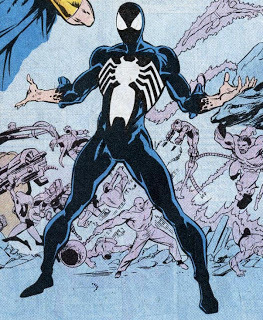 Mark Bagley Spider-Man from "What If"Winners received this certificate:
Mark Bagley Spider-Man from "What If"Winners received this certificate:
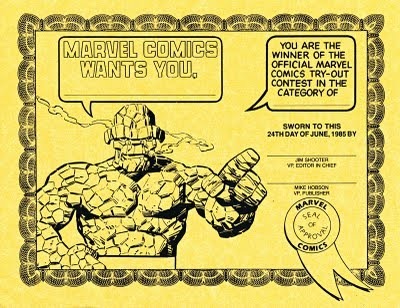 Winners were also promised that they would complete the unfinished story presented in the Try-Out Book, "Personals," which would be published as a Spider-Man special issue.
Winners were also promised that they would complete the unfinished story presented in the Try-Out Book, "Personals," which would be published as a Spider-Man special issue.
I don't think we ever accomplished the latter. I don't remember a specific reason why. But, trying to organize a particular group of people to create a comic book falls north of cat-herding on the degree of difficulty scale sometimes. Also, I believe that would have been in 1986, toward the end of my tenure as Editor in Chief, during a time when I was busy battling the greed-monsters of Cadence Management, Inc. who were trying to sell us comics people down the river. My attention was largely diverted.
Anyway….
Years later, in 1994, I believe, I went with my girlfriend to a fancy restaurant in Manhattan called the Ocean Club. We were ushered to the best table in the house (?!) and served complimentary beverages (?!). Then the Maitre d' or manager—I forget, but, whatever, he was the boss—came over and introduced himself. He was Chuck Duffie, the Try-Out Contest's winning writer, doing pretty well, it seemed, albeit not in comics.
MONDAY: Heroes for Hope and Why I Don't Like Oxfam America


That was back in the 1960's, of course. Readers were pleased and honored to see their suggestions make the "Bits…" section and apparently thrilled if their idea was developed into a continuing character. Seeing your name, your character's name and five-word description in print was great, and seeing your character developed and appearing on panel, well…that was awesome. Reward enough for your efforts.
"Bits of Legionnaire Business" Excerpts
Adventure Comics 354, March 1967
Dear Editor:
Lately, much attention has been given to Jeff Greenberg for his creation of Color Kid, now a member of the Legion of Substitute Heroes. It is my sad duty to inform you that he did not create Color Kid. In issue No. 311, Leslie Leibow, of Fairlawn, N.J., sent in Color Kid as a Bit of Legionnaire Business. When will you give credit where credit is due?
-Elizabeth Kane, East Meadow, N.Y.
(We already have, Liz - by crediting the first fan to send the idea in. Jeff's Bit of Business appeared in No. 309. And speaking of Jeff, read the next letter. -Ed.)
Dear Editor:
Thank you! Thank you! I am so proud! You have made Color Kid one of your most vivid and exciting new characters. Even though he is only a Substitute Legionnaire, he was the hero of "The Forgotten Legion" (which was one of your best stories in months). And why am I so proud? Because he's my character - I created him in your Bits of Legionnaire Business column. Well, I've made my contribution!
-Jeff Greenberg, Los Angeles, Calif.
(You sure have, Jeff! We fell your boy adds a great deal of color to the Substitute Legion - so there's no telling when he'll pop up next. -Ed.)
No, this isn't a nostalgic yearning for the good old days. I wondered about the propriety of that practice even then. These days, I wonder about news and weather shows on TV that invite people to send in pictures or video. Let's see, I send you spectacular video that fills air time for you and my reward is seeing my effort on TV, helping you amuse your audience and make your money…. Hmm.
Nah.
As far as I know, we never used anything without compensation from the submissions and samples we reviewed by the literal ton at Marvel back while I was there, 1976-87. There were some cases in which we saw something, liked it and bought it. The Black Spider-Man costume comes to mind. The correspondent sent in a sample plot in which Spider-Man is given a new, black costume by Reed Richards that has high-tech features. I called the guy up. His plot wasn't up to professional standards, but I offered to pay him for it anyway, to "buy the idea." He was very happy with that.
I had no thought about where or when I might want to put Spider-Man in a black costume. I put a note in my drawer. A long time later, maybe a year, I needed an event for Secret Wars and remembered the black costume idea. I figured it was going to be a throwaway bit, something we'd use once.
Developed first by me, then by David Michelinie and editor Jim Owsley (now Christopher Priest), the costume became a character and went on to great things, even being featured in a movie. Though the only thing he contributed to the black Spider-Man costume were, essentially, the two words "black costume," I think Marvel owes the guy who strung those words together more money.
In another case, woman sent in a plot for a graphic novel. I liked the ideas. She wasn't ready for prime time, though, but with a great deal of help from the editor and brilliant artist Berni (now "Bernie"—geez, can't anybody just pick a name and stick with it?) Wrightson, her story saw print and did well. I wonder whatever happened to her. It seemed to me she had great potential.
Once, at VALIANT, an artist named—I'm pretty sure I have this right—Dennis Woodyard showed me samples. I was looking at the drawing more than the content. We couldn't offer him a gig at that point.
A year or so later, JayJay and I cooked up a new character, Gilad Anni-padda and decided to title the series he would appear in Eternal Warrior. The title was my idea, I believe. Right, JayJay?
(Yep, and his name, Gilad. - JayJay)
When the first ads came out, who should turn up at the office again but Dennis Woodyard. Turned out the art samples he'd shown me featured a character of his own creation, Eternal Warrior.
Oops.
I had blanked on that entirely. I was unaware that I had used the same name. The characters were completely different by the way.
So, we worked something out. Since our book was already in production and his wasn't, he graciously changed his character's name and allowed us to continue with Eternal Warrior in return for some compensation, including free advertising for projects of his. At that point, we were just starting to take off and we still didn't have much money.
So, I understand why, these days, creators fear losing control of their creations and companies fear legal exposure to the point that they don't want to see any submissions or samples for fear of an Eternal Warrior situation or worse.
That said, it seems to me sometimes that everyone these days has become a little too paranoid, a little too precious about any little snippet of an idea they might have.
Here's the nostalgic yearning for the good old days part….
It seems to me that not so long ago, creative people had more of a sense of community. We were very free with thoughts and suggestions, or even pitching in on a creative barn-raising.
Len Wein needed a science fiction-y adversary for an issue of Thor Walt Simonson was drawing. Among those of us drained, desiccated husks hanging around the office late after hours listening to Len and Walt plot the issue was Roger Stern. Rog said, "How about 10,000 chrome armadillos?" Everybody laughed, Walt made a note and the rest is comics history, however improbable.
Another time, I needed a name for an Avengers villain who had control over gravity. "Graviton" said Len, hardly looking up from whatever goofing off he was doing. Len is good with names.
Nobody thought anything of such things.
And now, this….
The success of the first release of the Try-Out Book inspired us to do a second release. We promoted it using "The Great Try-Out Contest." The idea was that we would sell some books and find great new talent among the winners and best entries.
I'd say it worked. Several of the winners went on to do a lot of work in comics. Here's the list again:
 Mark Bagley, in particular, went on to become a notable artist. I don't think the winning writer, Chuck Duffie, ever did any other work in comics.
Mark Bagley, in particular, went on to become a notable artist. I don't think the winning writer, Chuck Duffie, ever did any other work in comics.
 Mark Bagley Spider-Man from "What If"Winners received this certificate:
Mark Bagley Spider-Man from "What If"Winners received this certificate:
 Winners were also promised that they would complete the unfinished story presented in the Try-Out Book, "Personals," which would be published as a Spider-Man special issue.
Winners were also promised that they would complete the unfinished story presented in the Try-Out Book, "Personals," which would be published as a Spider-Man special issue.I don't think we ever accomplished the latter. I don't remember a specific reason why. But, trying to organize a particular group of people to create a comic book falls north of cat-herding on the degree of difficulty scale sometimes. Also, I believe that would have been in 1986, toward the end of my tenure as Editor in Chief, during a time when I was busy battling the greed-monsters of Cadence Management, Inc. who were trying to sell us comics people down the river. My attention was largely diverted.
Anyway….
Years later, in 1994, I believe, I went with my girlfriend to a fancy restaurant in Manhattan called the Ocean Club. We were ushered to the best table in the house (?!) and served complimentary beverages (?!). Then the Maitre d' or manager—I forget, but, whatever, he was the boss—came over and introduced himself. He was Chuck Duffie, the Try-Out Contest's winning writer, doing pretty well, it seemed, albeit not in comics.
MONDAY: Heroes for Hope and Why I Don't Like Oxfam America
Published on September 09, 2011 10:32
September 8, 2011
The Startling Conclusion of the Submission Saga
First This:
Sorry I've been late so often of late. Anyone who has multiple deadline clocks ticking knows that when something unexpected comes up, the other things all start bumping up against each other. Then my best-laid schemes gang aft agley.
Yesterday, I had to take an unexpected trip to Binghamton, New York and back. After seven white-knuckle hours behind the wheel through a blinding, interminable downpour, I wasn't at my energy-level best, and I had to put out the hottest deadline fires first.
P.S., the Susquehanna River overflowed its banks and Binghamton is largely inaccessible today. Got in and out just in time.
Back in the saddle again….
Now, This:
The technical illustrations in the Try-Out Book were done by Janet Jackson, an illustrator who showed me samples of tech-illos at a convention in Houston. It was her first work for Marvel Comics. I suggested many times that she might consider changing her name, for obvious reasons, to Sheena Easton or Celine Dion or something. She eventually began using the relatively pedestrian, unimaginative nom de guerre "JayJay." Yes, our JayJay, the Blog Elf herself.
 One of JayJay's technical illustrations, circa 1981.
One of JayJay's technical illustrations, circa 1981.
The Startling Conclusion of the Submission Saga
It was my policy to review submissions, and because I got away with it, that is, no one managed to thwart me, it was Marvel's policy.
Oh, some tried, from time to time. Every once in a while the house counsel or one of our outside, hired-gun intellectual property lawyers would raise the scary specter of legal exposure, meaning what if somebody sues us claiming something we're doing was lifted from their submission?
I looked into it. I'm not a lawyer, but I'm fairly good at reading. A little research told me that our "exposure" was minimal. From what I could ascertain, Marvel didn't really run much risk reviewing submissions sent in by people freely and of their own will. Especially those involving our own characters, as nearly all did.
My arguments were sufficiently persuasive that I managed to beat back the interference from legal types every time. And, I believe, my policy endured after I was gone.
Maybe I should have been a lawyer.
Nah.
Times have changed. In recent years, the pendulum has swung more to the side of people who make claims that commercially successful properties were based upon, inspired by or outright ripped off from their submissions or suggestions. The courts have looked with increasing favor upon such claims and there is ample precedent to embolden claimants. Especially in the big-money media, like movies and music.
Not long ago, virtually every single movie made precipitated a gaggle of lawsuits, mostly by people with flimsy claims hoping that the studios would pay them some small amount—say $100,000—to go away, rather than defend themselves in court, which could cost more. The costs were getting out of hand. So, the studios have become increasingly risk-averse, and these days, studios are loathe to finance films that do not have a clean chain of title for the intellectual property involved.
Printed comics aren't big-money, but movies based on comics are, so Marvel, DC, Dark Horse and others have become increasingly unwilling to so much as look at any samples or submissions. The fear of compromising the chain of title for anything is that great.
(ASIDE: In 1995, I think, I was asked to testify by Columbia Pictures in Federal Court. Someone was suing them over the Karate Kid movies, claiming that the idea was his, that, in fact, the story was based on his own experiences and that he created the name.
You'll notice if you look closely, that at the end of each KK movie there is a TM and Copyright notice identifying "Karate Kid" as the property of DC Comics, used by Columbia under license.
The Plaintiff asserted that he had created the name "Karate Kid" in 1968. I testified that I had created it, work-for-hire, for DC Comics in 1965, and brought a copy of the first issue of Adventure Comics in which Karate Kid had appeared, published in 1966, which was entered into evidence.
The judge told the jury to ignore my testimony as "hearsay." He said that for all he knew, I could have printed up that comic book in my basement the night before. I argued that the Statement of Ownership, which, coincidentally appeared in that issue, a Federal document (back then) was proof of authenticity—and that half a million copies had been sold, which with pass-along readership and subsequent appearances meant, undeniably, that the criteria for national exposure had been met. DC's lawyers submitted case law demonstrating that printed magazines (the Judge didn't consider a comic book a "magazine") were acceptable as evidence.
Anyway….
Columbia prevailed. Their lawyers told me I was the best witness they'd ever had since Clint Eastwood.
They gave me this tee-shirt as a thank-you.

Oh, and a dinner. At which they made a pitch to represent DEFIANT.)
Meanwhile, back at Marvel….
As explained yesterday, we had huge numbers of submissions pouring in. Interestingly, the Try-Out Book actually cut down the flow a little. Or, I guess, more accurately, I should say it slowed the rate of growth of the flow of submissions. I received this comment yesterday:
You see what I mean about the TOB discouraging submissions. Creating samples under "combat conditions" gave would-be submitters a much better idea of just how difficult the work that goes into a comic book is. Some judged themselves not ready and didn't send in their work.
Michael Fleisher once said about creating comics, words to the effect: "More work and skill and thought go into the least of our efforts than most people can imagine." He had a point. Some things that look like they might be easy turn out to be very difficult when you do them for real.
Once in a while, the submissions would pile up and I would commandeer all the assistant editors for a day to get us from Overwhelmed back to Whelmed. Here's a memo from my secretary regarding such a day, with my note scrawled on the bottom…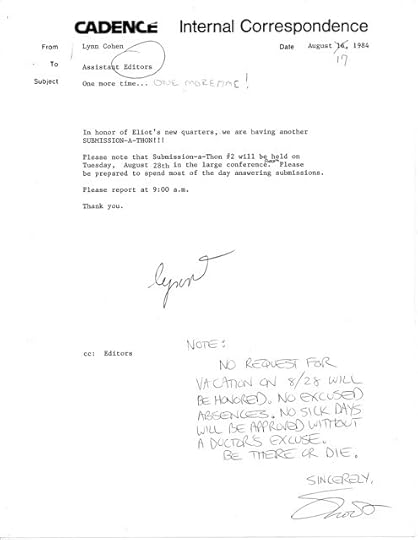
At this particular Submission-a-thon, I made sure an editor was present in the room throughout the day to make rulings on the judgment calls. They took turns. Even I took a turn.
The story you are about to read is true. The names have been changed to protect the incompetent.
On my shift, I heard two of the assistants, Dumb and Dumber, talking about a penciling submission, debating its merits or lack of same, saying things like it's a little cartoony, it's not "there" but pretty good, etc. I went over to take a look.
"These are Michael Golden pages," I said. "His package must have gotten into the subs pile by mistake. Give them to Larry Hama."
At least they knew the pages weren't form letter level.
NEXT: No, Really, This Time for Sure, the Startling Conclusion of the Submissions Saga
MONDAY: Heroes for Hope and Why I Don't Like Oxfam America
Sorry I've been late so often of late. Anyone who has multiple deadline clocks ticking knows that when something unexpected comes up, the other things all start bumping up against each other. Then my best-laid schemes gang aft agley.
Yesterday, I had to take an unexpected trip to Binghamton, New York and back. After seven white-knuckle hours behind the wheel through a blinding, interminable downpour, I wasn't at my energy-level best, and I had to put out the hottest deadline fires first.
P.S., the Susquehanna River overflowed its banks and Binghamton is largely inaccessible today. Got in and out just in time.
Back in the saddle again….
Now, This:
The technical illustrations in the Try-Out Book were done by Janet Jackson, an illustrator who showed me samples of tech-illos at a convention in Houston. It was her first work for Marvel Comics. I suggested many times that she might consider changing her name, for obvious reasons, to Sheena Easton or Celine Dion or something. She eventually began using the relatively pedestrian, unimaginative nom de guerre "JayJay." Yes, our JayJay, the Blog Elf herself.
 One of JayJay's technical illustrations, circa 1981.
One of JayJay's technical illustrations, circa 1981.
The Startling Conclusion of the Submission Saga
It was my policy to review submissions, and because I got away with it, that is, no one managed to thwart me, it was Marvel's policy.
Oh, some tried, from time to time. Every once in a while the house counsel or one of our outside, hired-gun intellectual property lawyers would raise the scary specter of legal exposure, meaning what if somebody sues us claiming something we're doing was lifted from their submission?
I looked into it. I'm not a lawyer, but I'm fairly good at reading. A little research told me that our "exposure" was minimal. From what I could ascertain, Marvel didn't really run much risk reviewing submissions sent in by people freely and of their own will. Especially those involving our own characters, as nearly all did.
My arguments were sufficiently persuasive that I managed to beat back the interference from legal types every time. And, I believe, my policy endured after I was gone.
Maybe I should have been a lawyer.
Nah.
Times have changed. In recent years, the pendulum has swung more to the side of people who make claims that commercially successful properties were based upon, inspired by or outright ripped off from their submissions or suggestions. The courts have looked with increasing favor upon such claims and there is ample precedent to embolden claimants. Especially in the big-money media, like movies and music.
Not long ago, virtually every single movie made precipitated a gaggle of lawsuits, mostly by people with flimsy claims hoping that the studios would pay them some small amount—say $100,000—to go away, rather than defend themselves in court, which could cost more. The costs were getting out of hand. So, the studios have become increasingly risk-averse, and these days, studios are loathe to finance films that do not have a clean chain of title for the intellectual property involved.
Printed comics aren't big-money, but movies based on comics are, so Marvel, DC, Dark Horse and others have become increasingly unwilling to so much as look at any samples or submissions. The fear of compromising the chain of title for anything is that great.
(ASIDE: In 1995, I think, I was asked to testify by Columbia Pictures in Federal Court. Someone was suing them over the Karate Kid movies, claiming that the idea was his, that, in fact, the story was based on his own experiences and that he created the name.
You'll notice if you look closely, that at the end of each KK movie there is a TM and Copyright notice identifying "Karate Kid" as the property of DC Comics, used by Columbia under license.
The Plaintiff asserted that he had created the name "Karate Kid" in 1968. I testified that I had created it, work-for-hire, for DC Comics in 1965, and brought a copy of the first issue of Adventure Comics in which Karate Kid had appeared, published in 1966, which was entered into evidence.
The judge told the jury to ignore my testimony as "hearsay." He said that for all he knew, I could have printed up that comic book in my basement the night before. I argued that the Statement of Ownership, which, coincidentally appeared in that issue, a Federal document (back then) was proof of authenticity—and that half a million copies had been sold, which with pass-along readership and subsequent appearances meant, undeniably, that the criteria for national exposure had been met. DC's lawyers submitted case law demonstrating that printed magazines (the Judge didn't consider a comic book a "magazine") were acceptable as evidence.
Anyway….
Columbia prevailed. Their lawyers told me I was the best witness they'd ever had since Clint Eastwood.
They gave me this tee-shirt as a thank-you.

Oh, and a dinner. At which they made a pitch to represent DEFIANT.)
Meanwhile, back at Marvel….
As explained yesterday, we had huge numbers of submissions pouring in. Interestingly, the Try-Out Book actually cut down the flow a little. Or, I guess, more accurately, I should say it slowed the rate of growth of the flow of submissions. I received this comment yesterday:
Jerry Bonner said... I suggested this story about the Try-Out book. Great to read it, Jim, and thanks for posting it!
I was only 12 or 13 when it came out and used my hard earned paper-route money to buy it. It really was awesome! I tried my hand at each section, although I never sent them in...because I fully realized I was only a kid and not ready for prime time….Thanks, Jerry.
You see what I mean about the TOB discouraging submissions. Creating samples under "combat conditions" gave would-be submitters a much better idea of just how difficult the work that goes into a comic book is. Some judged themselves not ready and didn't send in their work.
Michael Fleisher once said about creating comics, words to the effect: "More work and skill and thought go into the least of our efforts than most people can imagine." He had a point. Some things that look like they might be easy turn out to be very difficult when you do them for real.
Once in a while, the submissions would pile up and I would commandeer all the assistant editors for a day to get us from Overwhelmed back to Whelmed. Here's a memo from my secretary regarding such a day, with my note scrawled on the bottom…

At this particular Submission-a-thon, I made sure an editor was present in the room throughout the day to make rulings on the judgment calls. They took turns. Even I took a turn.
The story you are about to read is true. The names have been changed to protect the incompetent.
On my shift, I heard two of the assistants, Dumb and Dumber, talking about a penciling submission, debating its merits or lack of same, saying things like it's a little cartoony, it's not "there" but pretty good, etc. I went over to take a look.
"These are Michael Golden pages," I said. "His package must have gotten into the subs pile by mistake. Give them to Larry Hama."
At least they knew the pages weren't form letter level.
NEXT: No, Really, This Time for Sure, the Startling Conclusion of the Submissions Saga
MONDAY: Heroes for Hope and Why I Don't Like Oxfam America
Published on September 08, 2011 13:24
Try-Out Contest Artifacts
JayJay here. I found these items pertaining to the Marvel Try-Out Book that may interest you. Jim is presently typing his two fingers to the bone to get today's post done, so that will be up later!
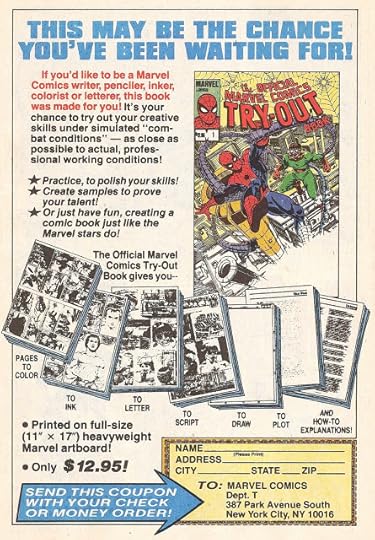
The items on Jim's desk in the ad below are accurate. He had a gumball machine that was usually filled with jellybeans and people would pop in all day to get some. They were free by the way. He had the creepy little monkey, too. The Captain America bear I made for him for his birthday one year. I bought the teddy bear and sewed a little satin Captain America suit for it and made a tiny shield. Jim is crazy hard to shop for! One small thing, though... the feet are colored wrong, they should be red since the bear had little boots. We can't remember who drew this.
We can't remember who drew this.
Was it one of the Raiders, maybe with John Romita Sr.'s help?
If anyone remembers, please comment!
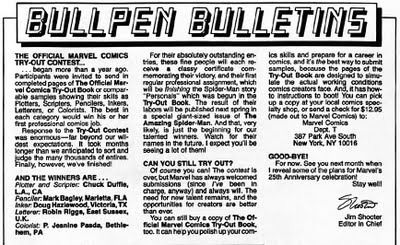


The items on Jim's desk in the ad below are accurate. He had a gumball machine that was usually filled with jellybeans and people would pop in all day to get some. They were free by the way. He had the creepy little monkey, too. The Captain America bear I made for him for his birthday one year. I bought the teddy bear and sewed a little satin Captain America suit for it and made a tiny shield. Jim is crazy hard to shop for! One small thing, though... the feet are colored wrong, they should be red since the bear had little boots.
 We can't remember who drew this.
We can't remember who drew this.Was it one of the Raiders, maybe with John Romita Sr.'s help?
If anyone remembers, please comment!

Published on September 08, 2011 09:43
September 7, 2011
Hijack!
JayJay here. Jim's away and... well, I'm not a mouse, but I'll play anyway. Here's something I thought you might enjoy. When I found my old Marvel Tryout Book to scan the pages for yesterday's blog there were some long forgotten newspaper articles stuck into it. Here's one from New York City Business, February 1985, about the Marvel Secret Wars and DC Crisis on Infinite Earths rivalry among other things.
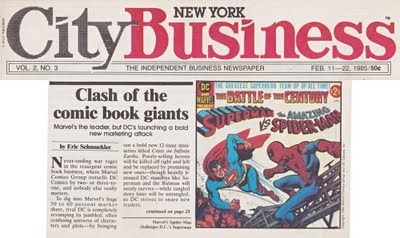

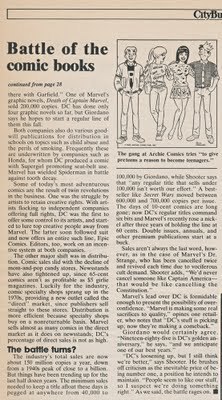 Tomorrow we'll return to our regularly scheduled blogcast: The Startling Conclusion of the Submission Saga
Tomorrow we'll return to our regularly scheduled blogcast: The Startling Conclusion of the Submission Saga


 Tomorrow we'll return to our regularly scheduled blogcast: The Startling Conclusion of the Submission Saga
Tomorrow we'll return to our regularly scheduled blogcast: The Startling Conclusion of the Submission Saga
Published on September 07, 2011 09:00
September 6, 2011
A Jerry Rice Needs a Joe Montana
First This:
My sincere apologies. I'm sorry today's post was so late that it drifted into tomorrow…that is, today. I'm trying. Sometimes life interferes with fun.
My previous post about answering submissions at Marvel garnered this comment by ~P~:
Here's my reply:
As I said, we at Marvel in general and I in particular had great respect for samples and submissions whether they were sent through the mail or shown to any of us representing Marvel at a convention. Marvel editorial personnel reviewed a lot of samples and submissions.
(ASIDE: In 1983 I arranged took every single Marvel Comics editor with me to the San Diego Comic-Con. I proposed to the show organizers that they use that as a promotional tool. In those days, Comic-Con still could have benefitted from promotion. I suggested that they announce that every single person from Marvel with the authority to hire creators would be at the show—"bring your samples." The organizers enthusiastically agreed, then did nothing. Not a press release I'm aware of, not an announcement of any kind, not a peep. Sigh.)
Occasionally, I received letters from people who wanted to submit samples asking all kinds of questions: "What kind of paper should I draw on?" "What kind of paints or colors do colorists use?" "What should an aspiring writer submit?" Some asked for photocopies of penciled pages. Made sense. Would-be pencilers who had never seen anything but printed books had no idea what penciled pages looked like. Would-be inkers had a similar problem. And the coloring process was a total mystery. We often sent photocopies of penciled pages and coloring-sized photocopies of finished pages, along with brief explanations, to people who seemed genuinely interested and reasonably of age.
Remember, I started when I was 13, so "of age" to me was a pretty low bar….
After a while, finally, a little light bulb went on in my head….
I walked into Publisher Mike Hobson's office with a stack of 18 Marvel art boards in my hands. "Picture this," I said. "A 32 page book, plus covers, printed on actual, full-size Marvel art boards…."
I went on to describe my idea for the Official Marvel Comics Try-Out Book. Mike loved it.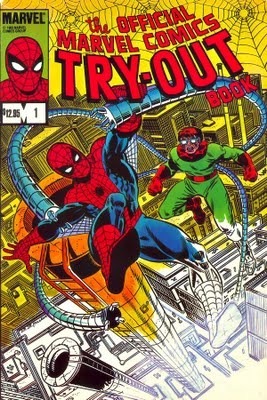
Here is the introduction to the Try-Out Book, which explains its nature and intent: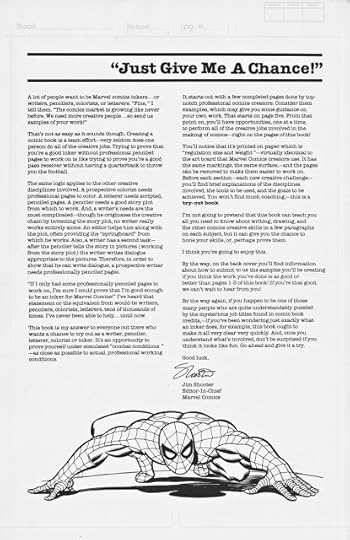 Click pics to enlargeHere are the explanation pages and some samples of the "try-out" pages. The pencilers' try-out pages were blank paper, albeit Marvel art boards, or as close as we could get. A publisher's dream—selling blank pages—but, in those days, there was no easy way I knew of to acquire comics art board. You could buy two-ply, kid finish Bristol board (some guys preferred plate finish, but Marvel's standard was kid finish) at some big city art stores, but not with the standard blue-line rules and divider marks. So, they were valuable, in their way.
Click pics to enlargeHere are the explanation pages and some samples of the "try-out" pages. The pencilers' try-out pages were blank paper, albeit Marvel art boards, or as close as we could get. A publisher's dream—selling blank pages—but, in those days, there was no easy way I knew of to acquire comics art board. You could buy two-ply, kid finish Bristol board (some guys preferred plate finish, but Marvel's standard was kid finish) at some big city art stores, but not with the standard blue-line rules and divider marks. So, they were valuable, in their way.
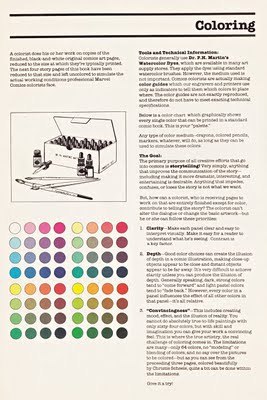

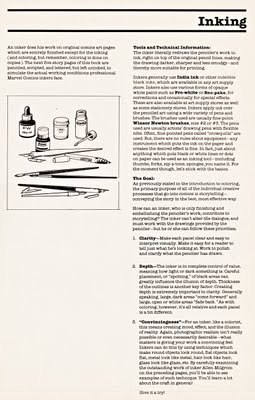
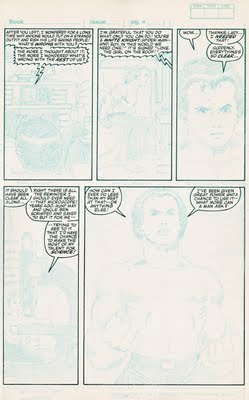
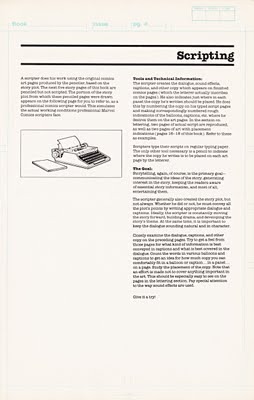
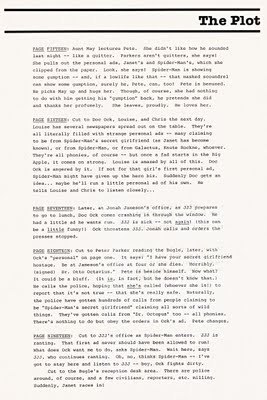
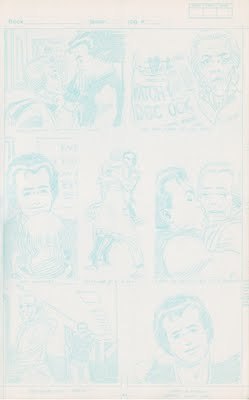
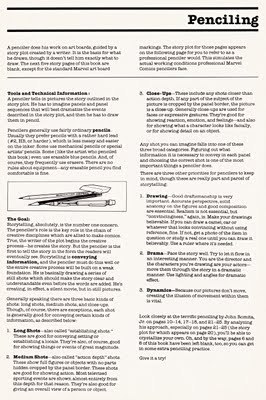
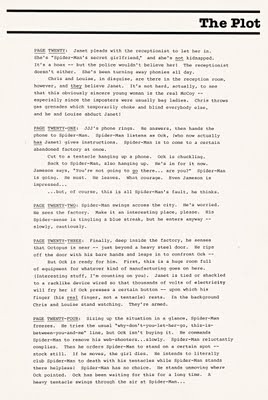
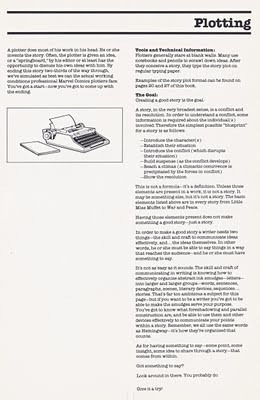
The Try-Out Book was a big success. It sold for $12.95 a copy, but believe it or not, that was a bargain. For you technical types out there, it had to be printed sheet-fed. Non-repro blue is a custom color, a "fifth color." And the cost of the paper? Ouch. It was the lowest price we could manage.
Shortly after the first edition of the Try-Out Book shipped, I was scheduled to do a series of store appearances in the Bay Area. I arrived at the first store on the tour to find a long line of people waiting for me (I was on time. I almost always am.) with books to sign, samples to show, or just to talk. I noticed that there were copies of the Try-Out Book on the store's shelves. Couldn't miss them, they're BIG.
Among the first few people in line was a fellow who had bought a Try-Out Book a day or two prior and had inked the inking try-out pages. He showed me the pages—still in the book, not pulled out. They were very good. I said, "I think we can offer you work." I gave him my card and I took his contact info down.
Suddenly half the people deserted the line to rush to the shelves to grab copies of the Try-Out Book.
If it had been a marketing stunt, it would have been brilliant. Nah. Just happened that way.
They sold out of the books in the Bay Area….
The guy's name is Art Nichols. Art went on to do a good bit of work for Marvel and later, for me at VALIANT. Artie, if you're reading this, please verify this story.
THURSDAY (I have an unavoidable mission tomorrow that involves a six-hour drive. Sorry.): The Startling Conclusion of the Submission Saga

My sincere apologies. I'm sorry today's post was so late that it drifted into tomorrow…that is, today. I'm trying. Sometimes life interferes with fun.
My previous post about answering submissions at Marvel garnered this comment by ~P~:
~P~ said...
Count me as yet another young hopeful, whom, after bleeding art and story on paper, I would swaddle my creations and send them "down the Nile" to the Marvel Submissions Office.
In the mid 1980's I had sent in a few samples of "panel-by-panel continuity" (as the office called it) and always received some encouraging replies (even though they were rejections). They may have been signed by YOU, Jim. (I saved these letters for many years, but think they were lost in a relocation.)
One time in the late 1980's, I sent in an original submission (an originally conceived horror story - no superheroes, just various types of architecture, creepy settings, and some nasty doings with top-hatted gentlemen, rabid dogs, rats, a burning castle and a vile succubus at the end).
The reply that I later received in the mail was photocopies of practically the entire volumes of some of Andrew Loomis' books; "Figure Drawing for All It's Worth" and another about film techniques and direction.
The letter included in the packet told me that they thought that I had a lot of "very close, but not quite there yet" talent, and that I should cram on the pages of the photocopied volumes.
While I would love to state that you were the correspondent, instead, the reply came from Carl Potts.
The only other time I received such deep, encouraging replies was from Mike Friedrich, to whom I had sent samples after being told to do so by Norm Breyfogle, after his seeing my work.
Neither venture led to any work, or any further contact past that point. Much of the blame falls upon my own shoulders, for not hammering out sample after sample (while striving to improve myself at each go-round).
Truthfully, I felt that I didn't want to "make a nuisance of myself" and avoided trying to jam my foot in the door (which, I guess would have been the better way to go).
Anyway, while I did manage to get a few independent comics under my belt (as writer and illustrator), the implosion of the 90's sort of shut the door on that.
But, I will ALWAYS be grateful to ANYONE who takes the time to actually LOOK AT and REPLY TO (hopefully, with encouragement) the blood, sweat and tears of hopeful talents.
These days, there are reality shows dedicated to trying to find the "next big thing" but when I was younger, no one wanted to even look at you.
Thank you, Jim.
And thanks to any like you who know what it's like to be on the outside looking in - waiting... waiting... for a chance.
~P~
September 2, 2011 9:46 PM
Here's my reply:
jimshooter said... By the time I became Editor in Chief, the volume of submissions was too great for me to handle. We had to go to plan B. We'd found that it made sense to use form letters for many subs, because we found ourselves saying the same things over and over in responses. We had at least 12 different form letters, one for each of the most common types of responses. Even those form letters usually were given a personal touch -- a signature by hand, a brief hand-written note added.... Interns sorted through the subs first and separated out those obviously done by little kids and, with help from my secretary Lynn and her assistant, responded. Assistant editors usually sorted the remaining subs and selected the proper form letter. Many didn't fall into a category covered by a form letter, and those got custom-made replies from assistants, art staff, editors or me. When a submission that was really outstanding turned up, it was shown to me. If I thought it merited special attention, I'd turn it over to John Romita or one of the editors to handle. I must have turned yours over to Carl, who was great with new talent. So was Milgrom. Owsley was great with writers, though few of those turned up. Hama was great, too. And John Romita, of course.
September 3, 2011 1:07 AM
As I said, we at Marvel in general and I in particular had great respect for samples and submissions whether they were sent through the mail or shown to any of us representing Marvel at a convention. Marvel editorial personnel reviewed a lot of samples and submissions.
(ASIDE: In 1983 I arranged took every single Marvel Comics editor with me to the San Diego Comic-Con. I proposed to the show organizers that they use that as a promotional tool. In those days, Comic-Con still could have benefitted from promotion. I suggested that they announce that every single person from Marvel with the authority to hire creators would be at the show—"bring your samples." The organizers enthusiastically agreed, then did nothing. Not a press release I'm aware of, not an announcement of any kind, not a peep. Sigh.)
Occasionally, I received letters from people who wanted to submit samples asking all kinds of questions: "What kind of paper should I draw on?" "What kind of paints or colors do colorists use?" "What should an aspiring writer submit?" Some asked for photocopies of penciled pages. Made sense. Would-be pencilers who had never seen anything but printed books had no idea what penciled pages looked like. Would-be inkers had a similar problem. And the coloring process was a total mystery. We often sent photocopies of penciled pages and coloring-sized photocopies of finished pages, along with brief explanations, to people who seemed genuinely interested and reasonably of age.
Remember, I started when I was 13, so "of age" to me was a pretty low bar….
After a while, finally, a little light bulb went on in my head….
I walked into Publisher Mike Hobson's office with a stack of 18 Marvel art boards in my hands. "Picture this," I said. "A 32 page book, plus covers, printed on actual, full-size Marvel art boards…."
I went on to describe my idea for the Official Marvel Comics Try-Out Book. Mike loved it.

Here is the introduction to the Try-Out Book, which explains its nature and intent:
 Click pics to enlargeHere are the explanation pages and some samples of the "try-out" pages. The pencilers' try-out pages were blank paper, albeit Marvel art boards, or as close as we could get. A publisher's dream—selling blank pages—but, in those days, there was no easy way I knew of to acquire comics art board. You could buy two-ply, kid finish Bristol board (some guys preferred plate finish, but Marvel's standard was kid finish) at some big city art stores, but not with the standard blue-line rules and divider marks. So, they were valuable, in their way.
Click pics to enlargeHere are the explanation pages and some samples of the "try-out" pages. The pencilers' try-out pages were blank paper, albeit Marvel art boards, or as close as we could get. A publisher's dream—selling blank pages—but, in those days, there was no easy way I knew of to acquire comics art board. You could buy two-ply, kid finish Bristol board (some guys preferred plate finish, but Marvel's standard was kid finish) at some big city art stores, but not with the standard blue-line rules and divider marks. So, they were valuable, in their way.










The Try-Out Book was a big success. It sold for $12.95 a copy, but believe it or not, that was a bargain. For you technical types out there, it had to be printed sheet-fed. Non-repro blue is a custom color, a "fifth color." And the cost of the paper? Ouch. It was the lowest price we could manage.
Shortly after the first edition of the Try-Out Book shipped, I was scheduled to do a series of store appearances in the Bay Area. I arrived at the first store on the tour to find a long line of people waiting for me (I was on time. I almost always am.) with books to sign, samples to show, or just to talk. I noticed that there were copies of the Try-Out Book on the store's shelves. Couldn't miss them, they're BIG.
Among the first few people in line was a fellow who had bought a Try-Out Book a day or two prior and had inked the inking try-out pages. He showed me the pages—still in the book, not pulled out. They were very good. I said, "I think we can offer you work." I gave him my card and I took his contact info down.
Suddenly half the people deserted the line to rush to the shelves to grab copies of the Try-Out Book.
If it had been a marketing stunt, it would have been brilliant. Nah. Just happened that way.
They sold out of the books in the Bay Area….
The guy's name is Art Nichols. Art went on to do a good bit of work for Marvel and later, for me at VALIANT. Artie, if you're reading this, please verify this story.
THURSDAY (I have an unavoidable mission tomorrow that involves a six-hour drive. Sorry.): The Startling Conclusion of the Submission Saga
Published on September 06, 2011 23:30
Slight Delay
JayJay here. Jim is delayed and we will be posting the blog a bit later today. 
Published on September 06, 2011 10:35
September 2, 2011
Submission Hold
In a corner of the Marvel Editorial office sat a huge pile of unopened mail. There was so much of it you couldn't describe it as a stack or a pile. More like a weary mountain, sort of leaning into the corner for support. If someone walked by quickly the air turbulence might cause a small avalanche, one or two envelopes sliding and bouncing down from the summit to the piedmont.
"What's all that?" I asked.
Submissions, I was told. People were always sending in samples and submissions.
"What do you do with them?"
Nothing, someone said. Hold onto them for a while. Sometimes, when Stan was out of town and his secretary got bored, she'd return some, unopened. If the pile got too big, they'd just throw them all away.
I asked if I could take care of them. Answer, words to the effect, "Knock yourself out."
It was 1976. I was brand new associate editor, fresh from Pittsburgh Pennsylvania. All my friends were back in the "Burgh. My girlfriend was back in the 'Burgh. I didn't have a lot to do after work except more work. And, occasionally hang out with the other new guy, Roger Stern. So, every night, I took a dozen or three of those submissions home with me.
Home was the YMCA. Not the nasty McBurney Y downtown. Past experience taught me not to trust that place. I stayed at the Vanderbilt Y on East 47th Street, a much nicer place.
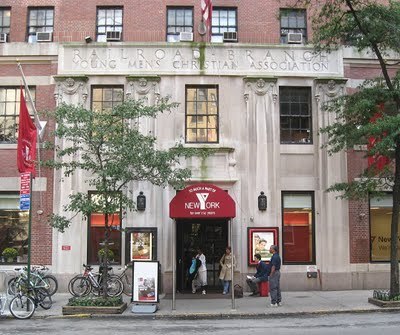
The Vanderbilt YMCA on East 47th Street, NYC
It wasn't that I couldn't afford an apartment—after all, I was making a cool $11,700 a year—even though rents in New York were absurdly high compared to Pittsburgh. The rent for a cramped, fifth floor walk-up dump in Manhattan that had no hot water was double what I paid for a nice, big, modern one-bedroom in Pittsburgh. Okay…I reconciled myself to that fact. But, still, finding an inhabitable, available walk-up dump, bribing the super, who you'd never see again and thus, snagging it before the other million people desperate to have it was a problem. Seemed like that was going to take some time.
The room at the Y was small, just barely big enough to fit a narrow little bed, a small dresser and what they called a desk. The bed took up most of the room. You couldn't open the dresser drawers because there wasn't enough room between the dresser and the bed. Couldn't sit at the desk for the same reason. The bathroom was down the hall.
They limited the time you could stay there. No more than six days in a row, I think. They didn't want people living there for extended periods.
Fine by me. The Y wasn't so bad for my purposes, actually. I took the bus or, once in a while, a plane (stand-by discount!) 400 miles back to Pittsburgh most weekends. The return bus left Pittsburgh at midnight. I went straight to work from the Port Authority Terminal Monday morning and Monday evening checked back into the Y.
And it was only seven bucks a night!
A few times, on weekends when I couldn't afford to go back to the home town, I had to check out of the Y and sit up all night at Chock full o' Nuts drinking coffee, waiting till the next morning when it would be okay to check back in. One time I couldn't hold up, and I took the cheapest hotel room I could find. At the Shelton, on Lex, I think. It broke my heart to part with the $18 it cost, but I couldn't keep my eyes open any longer. And, oh, the relative comfort of the good old Shelton Hotelton!
Anyway….
On a typical evening after work, I'd grab some cheap eats somewhere—you could eat at the Y for under two dollars if you weren't fussy about food—go to my little closet-room, sit on the bed and start in on the submissions. I wrote answers to each and every one. Short and as upbeat as possible to the crayon-on-paper-bag kid submissions, but sometimes long, detailed critiques to the rare submitter who showed some real talent.
All those letters were hand written. I didn't have a typewriter. Not even at work. And I couldn't type anyway. Still can't, unless you count this two-fingered pecking I do as typing.
Slowly, the mountain eroded away.
I remember one submission, a detailed story plot, from someone in England that was beautifully written, intelligent and thoughtful. The guy just needed to work on the architecture a little, plotting 101 stuff. But aside from those few structure quibbles, man, the thing was good. I sent him the most encouraging letter I could without a promise of work (which I had no power to make).
Never heard from the guy again, don't remember the name on the sub. Sometimes I wonder if it was Alan Moore or one of the other British Invaders who turned up years later.
Almost every day I'd come to the office and drop off a bunch of envelopes at the mailroom. The people I worked with thought I was nuts, bothering with submissions. But, I'd gotten my first job in comics by sending an unsolicited submission to Superman editor Mort Weisinger. I had tremendous respect and great sympathy for those who packed their best efforts into manila envelopes and sent them off to the home of their hopes and dreams.
I lived out of a suitcase at the Y for four months. Then one day this guy walked up to my desk at Marvel and said, "I heard you were looking for an apartment." He introduced himself. It was Dave Cockrum. He had a huge three bedroom out in Bellerose, Queens. He explained that he'd just split up with his wife, and without her salary he couldn't afford the place unless he got somebody to share it.
It had never occurred to me that living in a borough other than Manhattan was a reasonable alternative. Queens, huh? Commuting by bus and subway…?
Sure. You betcha. Had to be better than the current situation.
I took it sight unseen and moved into the back bedroom at Dave's place a few days later. It was six times the size of the closet-room at the Y, and the living room, kitchen, etc. we shared were modern and nice. We had a terrace! It overlooked the lot where they parked the Good Humor trucks, but still…. Wow.
By that time I had finished with the mountain and it was fairly easy keeping up with the incoming. I still took subs home once in a while. It was a lot more pleasant answering them on the comfy couch in the living room than sitting on the lumpy bed in that coffin-like Y room.
Many years later, late nineties, I think, I was at a convention in Ramapo, New York. I think it was organized in association with a school. They had an amazing number of professional guests for a small town show. I got to meet the great Kurt Schaffenberger at last. Never met him while working at DC.
Jerry Ordway saw me sitting at my table and came over. Out of his pocket, he pulled a very old, well-preserved, hand-written, long letter explaining the fundamentals of inking.
"Remember this?" he said.
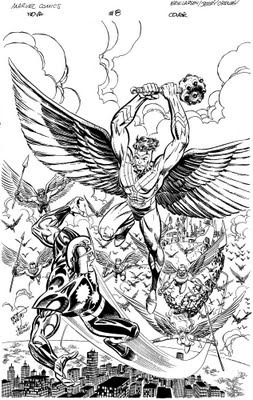
Nova #8 Cover Inked by Jerry Ordway
NEXT: A Jerry Rice Needs a Joe Montana
"What's all that?" I asked.
Submissions, I was told. People were always sending in samples and submissions.
"What do you do with them?"
Nothing, someone said. Hold onto them for a while. Sometimes, when Stan was out of town and his secretary got bored, she'd return some, unopened. If the pile got too big, they'd just throw them all away.
I asked if I could take care of them. Answer, words to the effect, "Knock yourself out."
It was 1976. I was brand new associate editor, fresh from Pittsburgh Pennsylvania. All my friends were back in the "Burgh. My girlfriend was back in the 'Burgh. I didn't have a lot to do after work except more work. And, occasionally hang out with the other new guy, Roger Stern. So, every night, I took a dozen or three of those submissions home with me.
Home was the YMCA. Not the nasty McBurney Y downtown. Past experience taught me not to trust that place. I stayed at the Vanderbilt Y on East 47th Street, a much nicer place.

The Vanderbilt YMCA on East 47th Street, NYC
It wasn't that I couldn't afford an apartment—after all, I was making a cool $11,700 a year—even though rents in New York were absurdly high compared to Pittsburgh. The rent for a cramped, fifth floor walk-up dump in Manhattan that had no hot water was double what I paid for a nice, big, modern one-bedroom in Pittsburgh. Okay…I reconciled myself to that fact. But, still, finding an inhabitable, available walk-up dump, bribing the super, who you'd never see again and thus, snagging it before the other million people desperate to have it was a problem. Seemed like that was going to take some time.
The room at the Y was small, just barely big enough to fit a narrow little bed, a small dresser and what they called a desk. The bed took up most of the room. You couldn't open the dresser drawers because there wasn't enough room between the dresser and the bed. Couldn't sit at the desk for the same reason. The bathroom was down the hall.
They limited the time you could stay there. No more than six days in a row, I think. They didn't want people living there for extended periods.
Fine by me. The Y wasn't so bad for my purposes, actually. I took the bus or, once in a while, a plane (stand-by discount!) 400 miles back to Pittsburgh most weekends. The return bus left Pittsburgh at midnight. I went straight to work from the Port Authority Terminal Monday morning and Monday evening checked back into the Y.
And it was only seven bucks a night!
A few times, on weekends when I couldn't afford to go back to the home town, I had to check out of the Y and sit up all night at Chock full o' Nuts drinking coffee, waiting till the next morning when it would be okay to check back in. One time I couldn't hold up, and I took the cheapest hotel room I could find. At the Shelton, on Lex, I think. It broke my heart to part with the $18 it cost, but I couldn't keep my eyes open any longer. And, oh, the relative comfort of the good old Shelton Hotelton!
Anyway….
On a typical evening after work, I'd grab some cheap eats somewhere—you could eat at the Y for under two dollars if you weren't fussy about food—go to my little closet-room, sit on the bed and start in on the submissions. I wrote answers to each and every one. Short and as upbeat as possible to the crayon-on-paper-bag kid submissions, but sometimes long, detailed critiques to the rare submitter who showed some real talent.
All those letters were hand written. I didn't have a typewriter. Not even at work. And I couldn't type anyway. Still can't, unless you count this two-fingered pecking I do as typing.
Slowly, the mountain eroded away.
I remember one submission, a detailed story plot, from someone in England that was beautifully written, intelligent and thoughtful. The guy just needed to work on the architecture a little, plotting 101 stuff. But aside from those few structure quibbles, man, the thing was good. I sent him the most encouraging letter I could without a promise of work (which I had no power to make).
Never heard from the guy again, don't remember the name on the sub. Sometimes I wonder if it was Alan Moore or one of the other British Invaders who turned up years later.
Almost every day I'd come to the office and drop off a bunch of envelopes at the mailroom. The people I worked with thought I was nuts, bothering with submissions. But, I'd gotten my first job in comics by sending an unsolicited submission to Superman editor Mort Weisinger. I had tremendous respect and great sympathy for those who packed their best efforts into manila envelopes and sent them off to the home of their hopes and dreams.
I lived out of a suitcase at the Y for four months. Then one day this guy walked up to my desk at Marvel and said, "I heard you were looking for an apartment." He introduced himself. It was Dave Cockrum. He had a huge three bedroom out in Bellerose, Queens. He explained that he'd just split up with his wife, and without her salary he couldn't afford the place unless he got somebody to share it.
It had never occurred to me that living in a borough other than Manhattan was a reasonable alternative. Queens, huh? Commuting by bus and subway…?
Sure. You betcha. Had to be better than the current situation.
I took it sight unseen and moved into the back bedroom at Dave's place a few days later. It was six times the size of the closet-room at the Y, and the living room, kitchen, etc. we shared were modern and nice. We had a terrace! It overlooked the lot where they parked the Good Humor trucks, but still…. Wow.
By that time I had finished with the mountain and it was fairly easy keeping up with the incoming. I still took subs home once in a while. It was a lot more pleasant answering them on the comfy couch in the living room than sitting on the lumpy bed in that coffin-like Y room.
Many years later, late nineties, I think, I was at a convention in Ramapo, New York. I think it was organized in association with a school. They had an amazing number of professional guests for a small town show. I got to meet the great Kurt Schaffenberger at last. Never met him while working at DC.
Jerry Ordway saw me sitting at my table and came over. Out of his pocket, he pulled a very old, well-preserved, hand-written, long letter explaining the fundamentals of inking.
"Remember this?" he said.

Nova #8 Cover Inked by Jerry Ordway
NEXT: A Jerry Rice Needs a Joe Montana
Published on September 02, 2011 09:16
September 1, 2011
Animal House
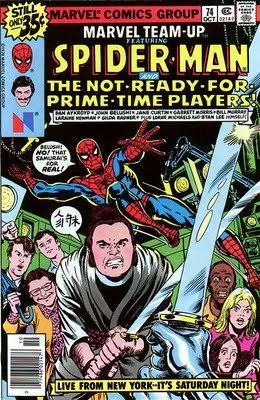 Sometime in early 1978, Chris Claremont proposed that Spider-Man meet the "Not Ready for Prime Time Players" in an issue of Marvel Team-Up.
Sometime in early 1978, Chris Claremont proposed that Spider-Man meet the "Not Ready for Prime Time Players" in an issue of Marvel Team-Up.For any of you who were born last week, the Not Ready For Prime Time Players are the cast members of Saturday Night Live. If you don't know about SNL then ask mommy if you can stay up late one Saturday night or, better yet, check out the Saturday Night Live DVDs that contain classic material, like SNL The First Five Years or The Best of John Belushi .
SNL was the hipness barometer back in those days. If, on Monday morning, you weren't guffawing about "Samurai Delicatessen" or "Weekend Update" around the coffee shrine you probably still wore white socks and put pennies in your loafers.
 The editor of Team-Up, at that point, was Bob Hall. Bob was show biz oriented. As a matter of fact, a play he had co-written, The Passion of Dracula, was running at the Cherry Lane Theater down in the Village at the time.
The editor of Team-Up, at that point, was Bob Hall. Bob was show biz oriented. As a matter of fact, a play he had co-written, The Passion of Dracula, was running at the Cherry Lane Theater down in the Village at the time.I had more than a few things on my mind right about then, so other than saying "Why not?" I had precious little to do with the project. Bob and Chris talked the SNL people and producer Lorne Michaels into it, somehow an agreement got done and signed and work began.
Bob and Chris did all the interfacing with SNL and made the thing happen. Bob, who is a very good penciler, drew the story. That made sense on a number of levels—he was already involved in the project, had done the research and, I believe, had even been to the set with Chris. And he had the show biz experience to know what he was looking at when he went backstage. Too hard to explain it all to somebody else.
Bob and Chris recruited the wonderful Marie Severin to ink and color the book. Marie is a great artist in general and amazing at likenesses. Her caricatures are legendary, of course.
Annette Kawecki lettered the story.
Because Bob was drawing the book, and because it was an important, high-profile project in my opinion, I got more hands-on involved with the editing than usual. It wasn't hard. Everyone involved did first-class work.
So, the book got done. I thought it came out pretty well.
Okay, everybody, it's a wrap, good job. Strike the set….
The book went on sale in late July. As we found out eventually, it sold very well in those almost-entirely newsstand days.
One day, soon thereafter, the receptionist told me that John Belushi was on the line and wanted to speak with me.
Well, number one, I didn't believe that it was really Belushi. Probably a gag.
Then, I had momentary wave of paranoia. What if it really was him and he didn't like the book? What if he was angry? What if we screwed up somehow and he was going to sue us?
Nah. Turned out it was the real Belushi and he loooved the book! He was excited. He asked me if it would be possible for him to come up to the office and see us.
You betcha. No problem, John.
For a freelancer who worked at home, Chris seemed to always be in the office. Part of that was because he was a fussbudget who mother-henned to death everything he worked on. He wanted to see the inks, the lettering, the coloring, double-check and proofread everything. There should be more creators that conscientious. So, he may have been in the office already, or maybe we called him and told him to get down to 575 Mad Ave from Inwood where he lived quick like a Killer Bee. Whatever. Chris was there when Belushi showed up.
We gave Belushi the tour. He seemed more excited to meet us and see the offices of Marvel Comics than we were to meet him, if that's possible. He said he was a huge Marvel Comics fan. In the big editorial room we had all the current covers hung up on one wall. Belushi told us the plot of each book represented on that wall to prove he'd read them!
Nearly everybody who wasn't wearing white socks gathered in the editorial room to listen, laugh and hang out for a few minutes with Belushi. Chris, of course, was front and center. The brief conversation rambled between our work, his work and the Spider-Man/NRFPTP Team-Up.
Speaking about his difficulties writing the story, Chris said this: "John, you have no idea how hard it is to write comedy."
Belushi did an incredulity "take." Beat. "YES, I DO!"
Big laughs.
Ask Chris. He'll sheepishly own up to that.
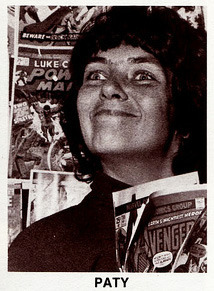 Then, suddenly Paty Greer came in with her hair pulled back, brandishing a T-square as if it were a katana, doing a "Samurai Paste-Up" routine of her own invention.
Then, suddenly Paty Greer came in with her hair pulled back, brandishing a T-square as if it were a katana, doing a "Samurai Paste-Up" routine of her own invention.More big laughs.
Belushi had to leave too soon, but before he did he invited those of us who had worked on the Team-Up story to the opening night party for Animal House, which was coming up in a few days.
On the evening of July 27, Chris, Bob and I made our way to the Village Gate, a big, legendary nightclub on the corner of Thompson and Bleecker. I think we were the only ones who went. Bob or Chris would know for sure. We told the door keepers that we were invited by Belushi. They hadn't been told and we weren't on the guest list. Somebody said they'd go find Belushi.
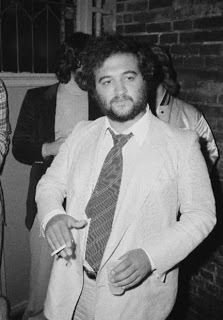
John Belushi at the Village Gate, 1978
I think we stood there waiting for 45 minutes or so. Finally, as we were about to give up, Belushi came to the door and escorted us in!
Belushi spent more than an hour with us. He took us all around and introduced us to people, especially members of the NRFPTP who were there—Garrett Morris, Laraine Newman, Gilda Radner and more. Michael O'Donoghue, I think? Again, Chris and Bob could probably provide the complete list. Bob was in love with Gilda Radner. How could you not be?
We had a blast. That said, to our credit, we stayed out from underfoot and didn't overstay our welcome. It was an honor to spend some time there, but it wasn't our party, and we respected that.
It was a spectacular night.
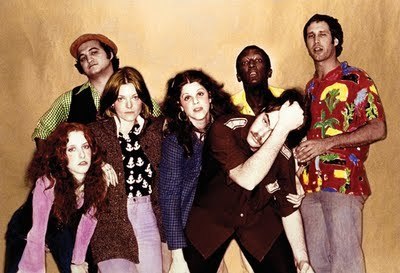
The Original SNL Cast
I put Belushi on the comp list for everything Marvel published for life.
Life, as it turned out for Belushi, was way too short.
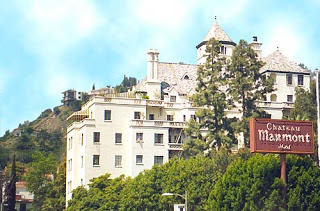 On March 5, 1982, in Bungalow #3 of the Chateau Marmont Hotel Belushi died from too many speedballs delivered and administered by drug-dealer-to-the-stars Cathy Evelyn Smith.
On March 5, 1982, in Bungalow #3 of the Chateau Marmont Hotel Belushi died from too many speedballs delivered and administered by drug-dealer-to-the-stars Cathy Evelyn Smith.I often stayed at the Chateau Marmont when in L.A., both before and after Belushi died. I usually took a suite in the main building, but once, years later, I stayed in Bungalow #3 because it was the only place available.
I wish I had a cool story about it. It just made me very sad.
NEXT: Submission Holds
Published on September 01, 2011 11:09
August 31, 2011
Son of Items of Interest
Here are some more things that turned up recently.
What If George Pérez Drew the Legion of Super-Heroes…?
George gave me this. This is the original drawing done for George's beautiful book PÉREZ* * ACCENT ON THE FIRST 'E'. It was published in 1977, I think. Marvel gave George a license to use its characters for no charge (or, maybe a dollar). I presume DC did the same. George autographed a copy of the book for me.
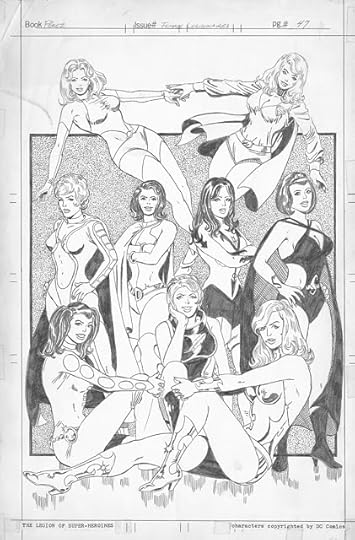
Forget Byrne, Here's the Art Team for SupermanFred Hembeck gave me this. I don't remember what the occasion was. Inks by star Joe Rubenstein and colors by the amazing Marie Severin.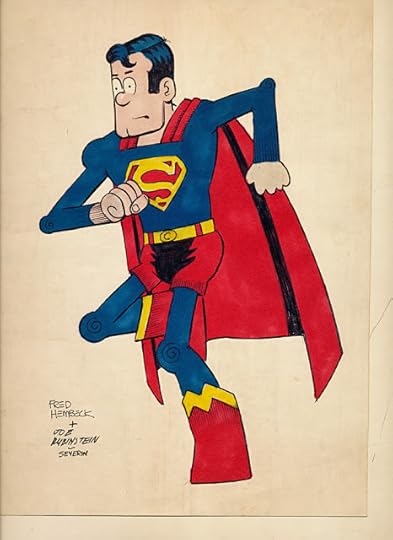
Speaking of HembeckThis, I believe, is Fred's first letter to me. I think this was done before he was being published by the Comic Buyer's Guide and Marvel. Cool, huh?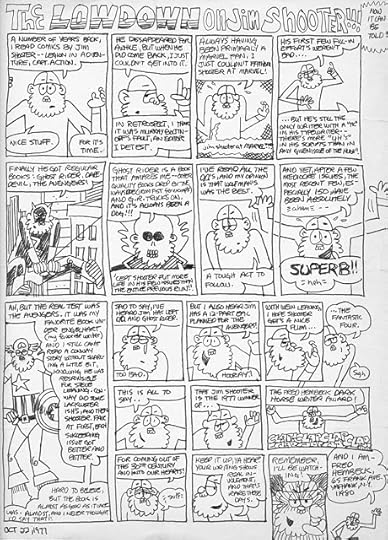
Cover GirlSomeone brought up Marvel photo covers a while ago and I mentioned that we had done one for Dazzler early on. I found one of the test shots taken during the shoot. The model was a young woman from Canada. This was probably her only job ever playing a super heroine.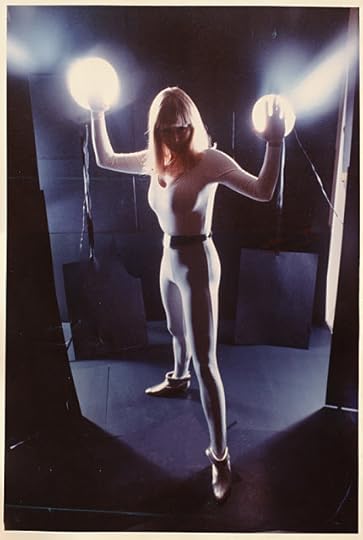
NEXT: Animal House

What If George Pérez Drew the Legion of Super-Heroes…?
George gave me this. This is the original drawing done for George's beautiful book PÉREZ* * ACCENT ON THE FIRST 'E'. It was published in 1977, I think. Marvel gave George a license to use its characters for no charge (or, maybe a dollar). I presume DC did the same. George autographed a copy of the book for me.

Forget Byrne, Here's the Art Team for SupermanFred Hembeck gave me this. I don't remember what the occasion was. Inks by star Joe Rubenstein and colors by the amazing Marie Severin.

Speaking of HembeckThis, I believe, is Fred's first letter to me. I think this was done before he was being published by the Comic Buyer's Guide and Marvel. Cool, huh?

Cover GirlSomeone brought up Marvel photo covers a while ago and I mentioned that we had done one for Dazzler early on. I found one of the test shots taken during the shoot. The model was a young woman from Canada. This was probably her only job ever playing a super heroine.

NEXT: Animal House
Published on August 31, 2011 10:36
Jim Shooter's Blog
- Jim Shooter's profile
- 85 followers
Jim Shooter isn't a Goodreads Author
(yet),
but they
do have a blog,
so here are some recent posts imported from
their feed.



